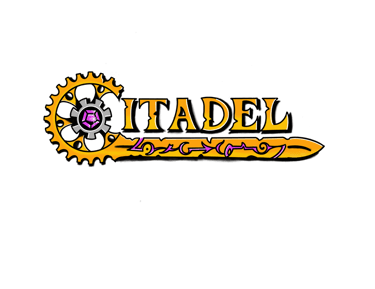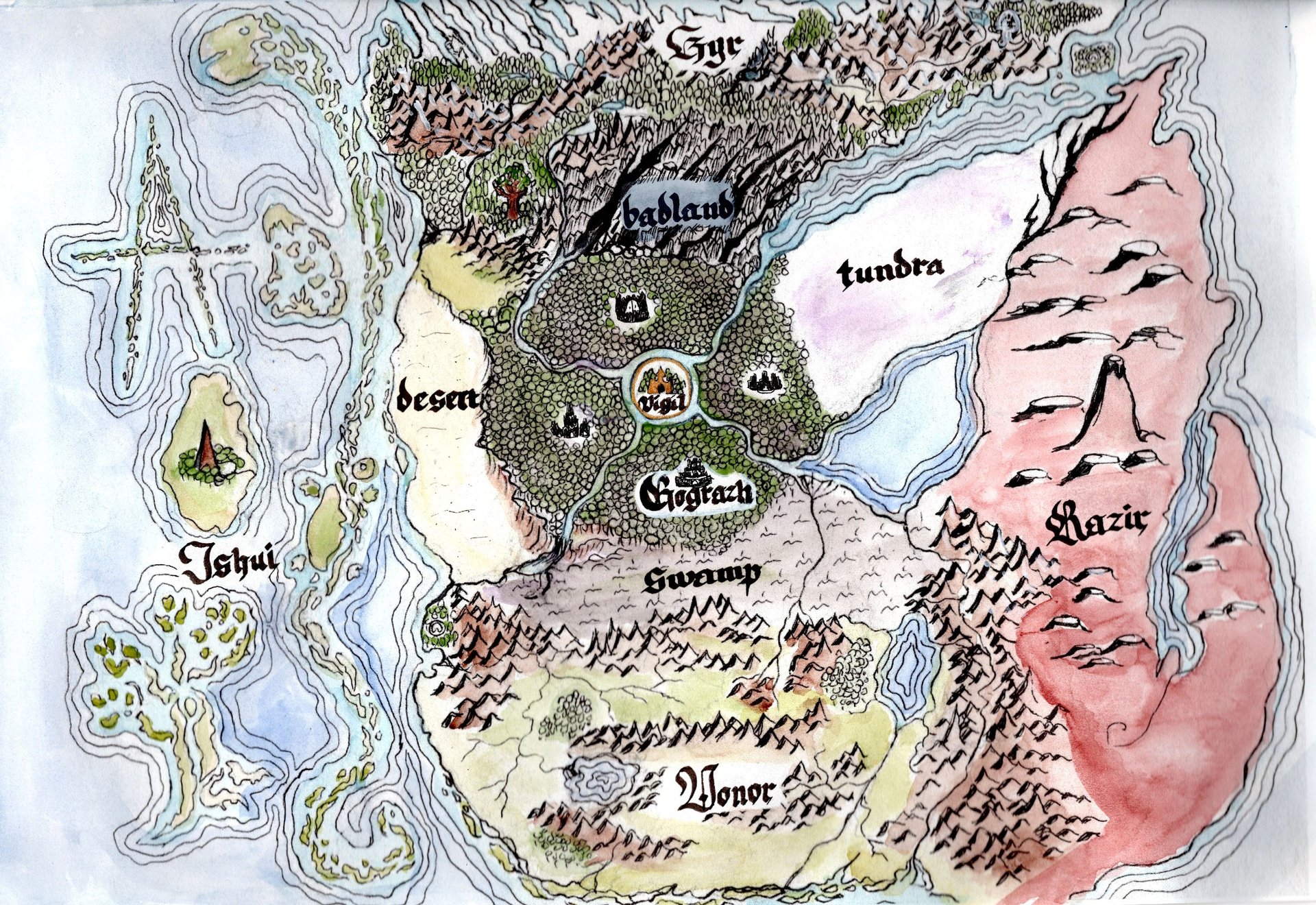
Inscription & Sigilcraft

Inscription is the art of infusing Essence into paper and ink, such as to copy magical formulations or create spell scrolls. Practitioners of this art, called Scribes, possess the precision necessary to copy magical formulations and rituals. They can also create spellscrolls, glyphs, and magical contracts. Some Scribes may also train in the art of Sigilcraft, which allows them to create Sigils to more quickly activate magical effects.



Trade Skills
General Information
The Trade Skills are skills that allow a character to create tagged items (items that are In-Play and can be used or sold within the game). Each Tier of a Trade Skill provides a character with five (5) Production Points per Production Period.
Additionally, each Trade Skill has a more magically focused skill associated with it. Artificer has Arcanatech, Inscription has Sigilcraft, and Physicker has Alchemy. Characters are not required to purchase the magical skills, but the Tiers of those magical skills require the character to have a specific level of the base skill. For example, to be eligible to purchase Arcanatech 1, the character must have Artificer 3.
Item Costs
Each item eligible to be crafted by a Trade Skill will have a listed Production Point cost and Material Unit cost. A character expends the associated cost to create the item. Production Points (PP) represent the character's ability and the time spent crafting the item. Material Units (MU) represent the basic components used in production. Examples include metal bars for Artificer, ink and parchment for Inscription, and herbs for Physicker Studies. Every item takes a certain number of MU to create the finished product.
The number of units remains constant for each item, but the market cost of Material Units for a given skill may fluctuate from event to event. These fluctuations are common knowledge and will be readily accessible to view. When a character uses their Trade Skill to craft an item, they can either supply their own Material Units or purchase them from the Production Marshal for the current rate. Note that the Production Marshal will only sell a player the Material Units needed to make the items they are crafting. Material Units can also be found In-Play or purchased from merchants or other players.
Production Periods
There are three times a character can use Production Points: at the beginning of an event, anytime during an event, or as an Between Game Action.
Beginning of the Event: At Check-In, you can spend up to your full amount of Production Points for each full day of the event. Any unspent PP will be noted on your character sheet and can be spent during the event. A typical weekend event is considered to be two (2) full days. For example, if you have Physicker 2 and are attending a weekend event, you have twenty (20) total PP to spend.
During an Event: Unspent PP can be used by collaborating with a Production Marshal. During most events, a Production Marshal will be In-Play at various times. The identity of the Production Marshal(s) will be noted during Opening Ceremonies.
Between Game Actions: The Between Game Action (BGA) used for Production allows a player 150% of their PP for a Production Period. Thus, if you have Artificer 4, you would have 30 PP to spend. The character is still required to pay the MU cost of these created items, and must turn in the cost at the next event's Check-In before they receive the item tags from their BGA.
Workshops
Workshops allow a character to increase the number of items that they can make during a given Production Period. Workshops are specific to a Production skill. All workshops cost 50 PP and 30 MU to create and require a formula. When using a Workshop, you gain 50% more PP. This applies to all of your PP for the event, and you can only use one Workshop per Production Skill per Event. A workshop can support any number of characters.
Each Workshop also has a special ability. You must visit the Workshop during play to use its special ability, and you can only use one Workshop special ability per Production Skill per Event. Multiple characters can use the same special ability each Event. The special abilities listed under each type of Workshop below are the ones currently offered by the Braided Band in Vigil. Other options can be discovered during play.
It is possible to steal a workshop, though as with any other theft, a Guide must be present. All workshops must have a phys-rep that is at least 2’ x 2’ x 2’. The permanent tag for the workshop should be attached to the phys-rep. The core phys-rep should be recognizable at a distance, but should be made of materials that are easily transportable and not fragile. Additional props for atmosphere are encouraged but not required. Workshops can be moved between locations without cost. An example Scriptorium is described below.
Scriptorium
Increases production for scribes and Sigilcrafters by 50%. Requires Inscription 5 or Artificing 5 to create.
Suggested Props: Portable desk, inks, paper or parchment.
Special Ability: Tranquil. 1/Event, you regain expended Intent equal to 25% of your maximum.


Inscription
Inscription is the art of infusing Essence into paper and ink, such as to copy magical formulations or create spell scrolls. Practitioners of this art, called Scribes, possess the precision necessary to copy magical formulations and rituals. They can also create spellscrolls, glyphs, and magical contracts. Some Scribes may also train in the art of Sigilcraft, which allows them to create Sigils to more quickly activate magical effects.
Every Scribe has a Book of Patterns containing all the spells that they know how to craft into spellscrolls, the Sigil Patterns they know, and any other Scribe Pattern they own. This book is an In-Play item and may be lost or stolen. Each Pattern is a text prop, and Scribes are able to duplicate them just as they can with other text props. A character that begins play as a Scribe chooses ten (10) spellscroll Patterns which they have the capability to craft to have within their Book of Patterns. When creating a spellscroll, a Scribe must have access to the physical text prop of the spellscroll's Pattern.
Scribes are also able to utilize their Production Points to copy Physicker and Alchemy Formulas, Artificer and Arcanatech Diagrams, Inscription and Sigilcraft Patterns, Wizard Rituals, and mundane manuscripts. The scribe must have the original manuscript on hand in order to make a copy.
Mundane text (i.e. just text, no in-game effect, such as a letter or page of a journal) does not require Inscription in order to copy it. Inscription is only required if Citadel Staff must provide the phys-rep for the copy (such as legal documents or Binding Contracts). Non-magical manuscripts may be copied at the cost of one (1) PP and one (1) Material Unit for five (5) copies or five (5) pages. It is not possible to forge signatures on such documents reliably.
Scribes may copy most production sheets (Physicker & Alchemy Formulas, Artificer & Arcanatech Diagrams, and Inscription Patterns) and spells (Wizard spells and Sigilcraft spells) for two (2) PP and two (2) MU. Higher level Formulas, Diagrams, Patterns, and spells may be more expensive, and some may not be copied. Exceptions will always be explicitly included on the sheet.
Each level of Inscription gives you five (5) Production Points per Production Period.


Inscription Tier Cost
Inscription 1 - 12XP
Prerequisites: none
Five (5) Production Points per Production Period.
Included Skill: Recycling. The Scribe is able to recycle unwanted spellscrolls. Spellscrolls may be recycled into Basic Ink MU for half their Material Unit cost.
Spellscrolls that have been activated are consumed upon activation and so cannot be recycled; Anything that expires at the end of the event (Paper Bombs, spells created by Spell Shorthand, etc) also cannot be recycled.
Inscription 2 - 5XP
Prerequisites: Inscription 1
Total of ten (10) Production Points per Production Period.
Inscription 3 - 8XP
Prerequisites: Inscription 2
Total of fifteen (15) Production Points per Production Period.
Included Skill: Paper Bombs. It takes a great deal of care to infuse Essence into ink and paper without unintended consequences, and just a small jot out of place could cause it to become unstable. A Scribe of this Tier has learned to harness that instability to their advantage. With one (1) minute of Concentration and roleplay, you may create either three (3) Lesser Paper Bomb Darts or one (1) Lesser Paper Bomb with a special effect. Due to the unstable nature of the magic, you may never have more than three (3) Darts OR one (1) effect paper bomb at a time. Paper Bombs function as a spellscroll in regards to activating them. As you gain more experience, it is possible to create more complex or more numerous paper bombs.
All Paper Bombs may only be activated by the Scribe who made them, and unused Paper Bombs expire at the end of the event.
See the Paper Bombs Table for more information.
Inscription 4 - 8XP
Prerequisites: Inscription 3
Total of twenty (20) Production Points per Production Period.
Inscription 5 - 8XP
Prerequisites: Inscription 4
Total of twenty-five (25) Production Points per Production Period.
Inscription 6 - 8XP
Prerequisites: Inscription 5
Total of thirty (30) Production Points per Production Period.
Included Skill: Binding Contracts. At this level of skill, a Scribe has learned to create Binding Contracts.
Five types of binding contracts exist: the Fellowship Contract, the Diplomatic Contract, the Domestic Contract, the Order Contract, and the Trade Contract.
See the Binding Contracts section for more information.
Inscription 7 - 10XP
Prerequisites: Inscription 6
Total of thirty-five (35) Production Points per Production Period.
Inscription 8 - 10XP
Prerequisites: Inscription 7
Total of forty (40) Production Points per Production Period.
Inscription 9 - 12XP
Prerequisites: Inscription 8
Total of forty-five (45) Production Points per Production Period.
Inscription 10 - 12XP
Prerequisites: Inscription 9
Total of fifty (50) Production Points per Production Period.


Scribes may carefully and meticulously infuse ink and parchment with a magical effect that can be activated at a later time. These spellscrolls can be stored indefinitely, but once activated, the magic consumes them.
Creating Spellscrolls
To create a spellscroll, a character must have a Production Pattern for the effect they wish to inscribe, and a Soul Bond to the Source they wish to use to empower it. If a Scribe lacks the Soul Bond required to create a specific scroll, Scribes may use Inscribing Ink (an Alchemy production item). Each vial of Inscribing Ink allows the Scribe to create a spellscroll empowered by an Aspect of Essence to which they do not have a Soul Bond.
A spellscroll is a piece of paper or other writable medium of at least 46 square inches in area. The standard form is half a standard piece of paper, or 5.5 inches by 8.5 inches. Players should have separate scroll props for different combinations of Source and Effect, but multiple copies of the same Source and Effect do not require separate props. At minimum, the phys-rep should include the tagline required to activate it, but may have additional writing if desired. The tagline to use the spellscroll is "Activate (Source) (Effect)”. Upon creating the scroll, the player receives a tag from Production. Multiple copies of spellscrolls with the same Source and Effect may all be included on one tag.
Using Spellscrolls
Some spellscrolls may be activated by anyone, but others require a specific level of Inscription or skill in wielding magic (a minimum amount of Wizardry Bones or Channeling Tolerance). A Scribe may always activate a scroll they are able to craft. Additionally, a Scribe may activate scrolls that are three (3) levels higher than the ones they are able to craft. So, for example, someone with Inscription 4 could activate a spellscroll that requires Inscription 7 to create.
In order to activate a scroll, a character must be touching or holding it in one hand and must have enough light to read the tagline written on the scroll. You are allowed to have other tagged items (such as a shield) in the hand holding the scroll. The tagline to use a spellscroll is “Activate (Source) (Effect)”. The most common type of spellscrolls are Battle type spells, which are cast using a thrown packet.
A scroll that has been activated cannot be used again; it is considered consumed upon activation. However, you are welcome to reuse whatever prop you have for the scroll as long as you have additional uses on a Production tag.
Spellscrolls


A Binding Contract is a legal document that incorporates magic in order to reward adherence to one's contractual obligations and punish the breach of obligations. Such contracts must have requirements that are clear in terms of both the obligations and the conditions under which those obligations have been violated. (A Marshal can reject a contract if it does not meet these requirements.) It takes greater skill and effort on the part of the Scribe to include stronger benefits, stronger punishments, greater durations above the contract type’s base duration, and escape clauses. Binding Contracts do not require production formulas, but it is recommended that Scribes have a description or examples of each type of contract within their Book of Patterns for quick reference, and they must be approved by a Marshal before they take effect.
Players should be aware that there are In-Game factions within the world that are very serious about maintaining the integrity of Binding Contracts. Insidious terms, coercive signing, or other misuses of Binding Contracts may result in legal or violent action against the player by those In-Game factions.
After a Binding Contract is created, additional signatories may be added to it as long as: 1) it doesn’t violate the contract to do so, 2) it doesn’t go above the contract type’s limit, and 3) the majority of current signatories agree.
For the purposes of sense magic, a character who is under a contract has an active magical effect upon them. Further investigation could reveal the source of the magical effect as being from a Binding Contract.
As a general Out-of-Play note: although PCs are welcome to draw from their own knowledge and experiences, do not expect Binding Contracts to be equivalent to modern-day contract law. We want these In-Play documents to be easily understood by any person, rather than require an Out-of-Play legal degree to interpret.
Binding Contracts

Benefits of a Contract
The main purpose of a Binding Contract, especially between allies, is to grant Benefits to the signatories as long as the terms of the contract are honored. Any Benefits added to the contract must also include total Penalties of an equal or greater Production Point value. All signatories receive the same Benefits, just as all signatories suffer the same Penalties. Benefits fade instantly upon violation of the contract’s terms or upon the specified duration of the contract.
Unless specified, a Benefit may only be added to a contract once. Additionally, if a character has signed more than one contract, you cannot gain the same Benefit(s) again (i.e Benefits cannot stack between contracts).
For example, if a character was a signatory on two contracts that each granted Fortitude, the character would only gain that Benefit once (as in their Bleed Out Timer would remain at ten (10) minutes rather than doubling again). As another example, if a character was a signatory on two (or more) contracts that granted Toughness, the character would only gain Toughness from one (1) contract.
See the Inscription Production tab of the Public Production spreadsheet for the Benefits and their cost.
Penalties for Violation of a Contract
All contracts inflict some measure of penalty upon signatories who violate the terms of the contract. The severity of these Penalties vary as they must be used to counterbalance the Benefits gained by the Binding Contract. In the case of Permanent contracts, the Penalties continue indefinitely, or until the other parties of the contract carry out any Escape Clause that may have been included.
Unless specified in its description, a Penalty may never be added more than once. Some Penalties may be added as an “Inclusive Penalty”. An Inclusive Penalty counts toward the PP balance with the contract Benefits, but doesn’t require the Scribe to spend PP on the Penalty. An Inclusive Penalty is immediately enacted upon the signatories in the same way the contract’s Benefits are, and continues for the entire length of the contract.
If a character is a signatory on more than one contract, the contracts may have the same Penalties, but cannot have the same Inclusive Penalties (i.e Inclusive Penalties cannot “stack” between contracts). A character who signs a contract with the same Inclusive Penalty as a contract they are currently an active signatory on would be considered in breach of the active contract.
See the Inscription Production tab of the Public Production spreadsheet for the Penalties and their cost.
Escape Clauses
Scribes can add escape clauses into contracts for one (1) additional Production Point per escape clause. An escape clause establishes conditions under which the signatories are no longer constrained by the terms of the contract, and will no longer enjoy its benefits or potential penalties. An escape clause can be as simple or as complicated as the Scribe wishes to make it.
Unless specified as such in an escape clause, the death of a signatory does not end a contract, unless only one (1) signatory remains. However, in the case of a Permanent Binding Contract, the one signatory would still be beholden to the contract unless the permanent death of all other signatories would make it impossible for them to fulfill the terms of the contract.

Types of Binding Contract
Every Binding Contract uses a framework based on one (1) of the five (5) types:
The Fellowship Contract, binding a small group of people for a specific purpose.
The Diplomatic Contract, binding those in leadership roles in various oaths of loyalty, fealty, peace, or alliance.
The Domestic Contract, most often used in the cases of marriage, adoption, and inheritance rights.
The Order Contract, binding those who join an Order to uphold the tenets of that Order.
The Trade Contract, in which parties agree to an exchange of goods, services, value, or knowledge.
A character may be a signatory in any number of non-conflicting contracts at a time, though determining whether a conflict has occurred can be a complicated matter. If a character signs two conflicting contracts, they would immediately suffer the penalties of both.
Durations are specifically for In-Play dates, not Out-of-Play real dates. When a Binding Contract is approved by a Marshal, the Marshal will note the current In-Play date and the In-Play date that the contract expires.
You can view examples of Binding Contracts here: Binding Contract Templates.
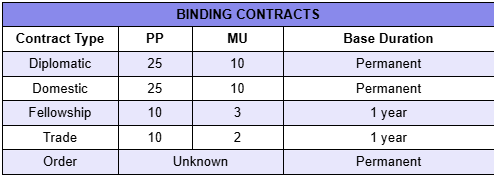


Fellowship Contract
A Fellowship Contract binds a group of people for a specific purpose or common goal. One of the most common types of Fellowships is a Fellowship of Wizards. At its baseline, a Wizardry Fellowship ensures that the wizards in it will not betray each other nor share the Fellowship’s collective secrets, and that the wizards will prioritize casting their spells together. Even when a group of Wizards trusts each other implicitly, they may decide to create a Fellowship Contract for the benefits it provides the group.
Fellowships are not limited to only Wizards, however. A Fellowship can include as few as three (3) and as many as sixteen (16) individuals who share a common goal or purpose. The Fellowship Contract should include a specific shared goal or purpose for the group. The base duration of a Fellowship Contract is one (1) year.
Diplomatic Contract
A Diplomatic Contract binds the leaders of two (2) or more factions into an oath of specified terms for themselves and the faction they rule. This type of contract is the only way in which a contract can bind those who are not signatories, even those not yet born as it is possible for the the signatory to sign for themselves and their descendants.
Diplomatic Contracts do not grant benefits or cause penalties to anyone beyond the signatories unless specifically stated in the contract (such as in the case of the descendants of the signatory). However, the signatories are beholden to the behavior of those they lead, and if their people act in a way that breaks the contract, they are considered in breach of contract. It is no surprise, then, that Diplomatic Contracts almost always have meticulously worded escape clauses for those sorts of situations.
Adding non-signatory individuals to the benefits and penalties of the contract increases the contract's cost, and the binding will only hold if one of the signatories has authority over that individual. For example, this could be used to add a child, a general of a leader’s army, or an apprentice.
Diplomatic Contracts have a base duration of Permanent, but usually include a number of Escape Clauses that allow the contract to end.
Domestic Contract
A Domestic Contract binds two (2) or more individuals into one (1) family. In some ways it is similar to a Fellowship Contract, as it unifies a group of individuals. However, a Domestic Contract is less about shared goals and rules and more about a shared love and responsibility. The most common form of Domestic Contract is in the case of marriage or adoption, as that creates a familial connection between individuals who previously did not have it. However, Domestic Contracts are also used for families who wish to clarify their responsibilities within the family and gain the benefits of a contract. A Domestic Contract will not bind if there is no clear responsibility for the signatories. In the case of a marriage, this could include things like forbidding or allowing additional intimate partners, clarifying if resources will be combined or kept separate, how an individual’s current or future debts will be handled, and how matters of inheritance will be handled. Domestic Contracts for adoption are not just for adults adopting children; they can be the adoption of an orphaned or disowned adult. This type of contract can also be used to adopt an individual into a family as a sibling, although that is rare without the approval of all parents of all included signatories.
Domestic Contracts have a base duration of Permanent. Escape clauses are possible, but uncommon.
Order Contract
An Order Contract binds an individual to adhere to the tenants, rules, and oaths of an Order. This type of contract is very similar to a Fellowship Contract, but rather than binding a small group to a common purpose, it binds a single individual into the common purpose of a large group.
A group is only eligible as an Order if it is internationally recognized as such, has members from every nation, and boasts a large membership. In the current age, there are five Orders: 1. The Academy of the Rising Wind, 2. The Braided Band, 3. The Caretakers of the Heartsgrove, 4. The Kinship of Pallas Adine, 5. The Wardens of the Endless Road.
Each Order has its own Order Contract that specifies the Orders mission, the benefits gained by signing it, and the individual signatory’s responsibilities. Order Contracts vary in length, but usually have Escape Clauses for if an individual no longer wants to participate in that Order. Signing more than one Order Contract is fairly common, although individuals must be careful to adhere to the tenants of each.
The exact method to create a Binding Order Contract is kept a secret within each Order. Player character Scribes are unlikely to ever spend production to create an Order Contract, but would understand how they function.
Trade Contract
A Trade Contract binds two parties into an agreement regarding the exchange of goods, services, currency, knowledge, or things of a more esoteric value within a fixed time period. Trade Contracts are the most common of all contracts, and many merchants use them on a day-to-day basis. Unlike other contracts, these do not inherently provide magical benefits to the signatories, although those can be added. Instead, the contract specifies what the exchange between the two parties will be and lists any penalties (magical or otherwise) that will occur if the exchange does not occur.
The obvious use of Trade Contracts is in the exchange of physical goods for money or other items of monetary value. However, there are many other uses for this type of contract. Academic Trade Contracts are common, as in the case of an apprenticeship, a student wishing to study under a master in their interested field of study, or involving the exchange and protection of intellectual property. Another common Trade Contract is a guardian agreement. An individual skilled in combat or magic agrees to provide protection for a person, item, or location in exchange for money or something else valuable. Trade Contracts are sometimes even used in the case of dispute resolution, arbitration, and to ensure compliance after an individual has been sentenced for a crime.
Trade Contracts are the most variable in duration, but the base duration is one (1) year or until the agreed upon exchange has occurred.



Spell Shorthand - 5XP
Prerequisite: Inscription 1
You are adept at preparing a few spell scrolls very quickly with whatever materials you happen to have on hand.
At the start of every event, you may prepare three (3) scrolls that each have a cost of five (5) or less PP and three (3) or less MU and they do not cost you anything to prepare. Because they are created with your unique shorthand and without the usual time and precision, the scrolls may only be used by you and deteriorate at the end of the event.

Swift Pen - 5XP
Prerequisite: Inscription 1
Once per event, you may copy a Pattern, Formula, Diagram, or Ritual without expending PP or MU on its creation.

Puzzle Enthusiast - 5XP
Prerequisite: Inscription 2
You enjoy studying puzzles, riddles, and other brain teasers.
Once per Reset, while in the presence of a Marshal, you may spend one (1) minute in Concentration and roleplay studying a puzzle and then receive a hint from the Marshal. The player is welcome to ask if this skill would grant a hint for other perplexing situations as well, which the Marshal may allow at their discretion.

Amateur Alchemist - 5XP
Prerequisite: Inscription 2
Scribes are often trained in a basic understanding of chemistry and botany in order to learn the art of ink making.
You are able to treat Alchemical Formulas that create ink as if they were a Scribe Patterns of the same PP cost (but must expend the correct MU for the Formula).

Recapture Essence - 5XP
Prerequisite: Inscription 3
Scribes understand the art of binding Essence within specific patterns, and use those ties to recapture magic that did not perform its intended purpose.
Once per Short Rest, you may spend one (1) minute in Concentration and roleplay to draw a Spell Feint rune upon yourself or another character. A character may only have one Spell Feint rune active at a time. While the rune is active, if the character uses magic and that spell misses (or is Dodged), the character may expend the Spell Feint rune to declare "Spell Feint" and refresh the use of that specific spell.
This ability works on any magical effect with the Activate or Magic tagline (including spellscrolls); it cannot be used for an effect with the Chemical tagline.
Recapture Essence 2 - 5XP
Prerequisite: Inscription 7 and Recapture Essence 1
You may now draw a Spell Feint rune two (2) times per Short Rest.
Recapture Essence 3 - 8XP
Prerequisite: Inscription 10 and Recapture Essence 2
You may now draw a Spell Feint rune three (3) times per Short Rest.

Crystal Memory - 5XP
Prerequisite: Inscription 3
You have a crystal clear memory in regards to anything written.
Once per Reset, you may commit one page of text to memory and keep the details of that clearly in mind for up to 24 hours. For that duration, you may copy that memorized page of text as if you had a physical copy. If the memorized text is a spellscroll, Wizard Ritual, Artificer Diagram, Alchemy Formula, or Sigilcraft Pattern, this ability does not allow the Scribe to activate or use it, only create a physical copy of it with their Production Points.

Sense Illusion - 5XP
Prerequisite: Inscription 4
Scribes are attuned to the smallest inconsistencies in their environment.
Once per Reset, you may activate a Sense Illusion effect.

Sense Bonds - 5XP
Prerequisite: Inscription 4
Scribes spend a great deal of time and study contemplating and enhancing their own Soul Bonds. This has given them insight on sensing the same ties in others.
Three (3) times per Short Rest, you may activate a Sense [X] Bond, where [X] is any Aspect of Essence to which the Scribe has a Soul Bond.

Intermediate Paper Bombs - 5XP
Prerequisite: Inscription 5
You have a great deal of experience with unstable creations and can now create two (2) Lesser Paper Bombs with a special effect, and are no longer limited by your Soul Bond. You may still choose to instead create three (3) Paper Bomb Darts.
All Paper Bombs may only be activated by the Scribe who made them, and unused Paper Bombs expire at the end of the event.
Advanced Paper Bombs - 5XP
Prerequisite: Intermediate Paper Bombs and Inscription 7
You have perfected your use of unstable creations and can now create up to three (3) Lesser Paper Bombs with a special effect, and are not limited by your Soul Bond.
Alternatively, you may create three (3) Paper Bomb Arrows (requires Soul Bond to the Aspect) or three (3) Paper Bomb Darts (does not require Soul Bond).
All Paper Bombs may only be activated by the Scribe who made them, and unused Paper Bombs expire at the end of the event.

Truthseeker - 5XP
Prerequisite: Inscription 6
The Scribe has heard enough stories in their time to tell the difference between truth and lies.
Once per Reset, the Scribe may activate Light Sense Truth

Story of the Scroll - 5XP
Prerequisite: Inscription 5
The Scribe understands that there is power in sharing a scroll's Story.
Three (3) times per Short Rest, you may spend one (1) minute roleplaying with storytelling, singing, or playing music to cause a beneficial scroll to target one (1) additional individual, or to grant one (1) individual the ability to use a scroll you can use, but they would normally not be eligible to use. They maintain the ability to use that scroll until their next Short Rest.
Ideally, the storytelling, singing, or music should in some way relate to the effect of the scroll. For example, a Scribe tells a story about a specific mountain, then uses a scroll for Earth Ward vs. Weapon, which can now target two (2) people.

Focused Instruction - 5XP
Prerequisite: Inscription 6
Scribes often take on the role of instructor, and a Scribe with this ability has practice instructing beginners in Inscription.
Once per Short Rest, you may spend ten (10) minutes roleplaying as a teacher for up to three (3) students who do not have any Inscription skills or who have a lower Tier of Inscription. At the end of that instruction, for the next one (1) hour, the student's are able to activate a spellscroll that normally requires Inscription 5.

Inscriptions of Naming - 5XP
Prerequisite: Inscription 8
There is power in a name, and you know how to Name Items. Named items involved in a great deed often hold an unusal resonance with Artificing, and are remembered throughout the ages. Inscriptions of Naming may be done before or after the item has been associated with a great deed. The Scribe determines what Source is used to Name it. There is no way to know what deeds might be truly great, or what the outcome might be once an item is Named.

Intentional Creativity - 5XP
Prerequisite: Sigilcraft 1
The intense focus required to utilize Intent can be exhausting for a Scribe, but spending time in a more free-form creative endeavor helps to refresh that Intent.
Once per Reset, you may spend at least ten (10) uninterrupted minutes doing something creative, such as sketching, painting, writing, or playing a musical instrument. At the end of that time period, you may Refresh half your total Intent.
Alternatively, you may expend this ability by spending one (1) minute in meditation and Concentration to Refresh three (3) Intent.
Intentional Creativity 2 - 5XP
Prerequisite: Intentional Creativity and Sigilcraft 2
You gain a second use of the Intentional Creativity ability, for a total of two (2) per Reset.
Additionally, the amount Refreshed when you expend this ability in the alternate way increases from three (3) to six (6) Intent.
Intentional Creativity 3 - 5XP
Prerequisite: Intentional Creativity 2 and Sigilcraft 3
You gain a third use of the Intentional Creativity ability, for a total of three (3) per Reset.
Additionally, the amount Refreshed when you expend this ability in the alternate way increases from six (6) to nine (9) Intent.


Paper Bombs Table

Sigilcraft
Essence flows through everything. Scribes of great skill understand how to direct that flow into Sigils in order to activate magical effects. Unlike spellscrolls that store the magic for longer periods and can be activated by many different people, a Scribe's Sigilcraft is a dynamic infusion of power that must be carefully released by the Scribe who creates it.


Sigilcraft 1 - 12XP
Prerequisite: Inscription 3
Total of ten (10) Intent.
First Sigils. Upon purchase of this skill, you may choose five (5) spell patterns from the Sigilcraft - Common Spells list to add to your Book of Patterns.
Sigilcraft 2 - 15XP
Prerequisite: Sigilcraft 1 and Inscription 5
Total of twenty (20) Intent.
The Scribe has learned the complex, precise language and Patterns needed for the Art of Glyphcraft, the oldest form of Inscription.
Glyphcraft. There are three categories of Glyphs: Blessing, Defense, and Barrier. Additionally, certain Defense and Barrier Glyphs may also incorporate a Sealing Glyph.
A Blessing Glyph is placed upon a threshold and grants a blessing to all who sleep in the room beyond that threshold. Defense Glyphs are designed to guard against specific creatures, unleashing magic on the specified creatures should they interact with it or pass by it. Barrier Glyphs are used by Scribes to create magical Walls and Circles.
Upon gaining this skill, the Glyphcrater gains the following Glyph Patterns:
Threefold Blessing
Setovai of Name
Razor Quill Defense Glyph
Sigilcraft 3 - 15XP
Prerequisite: Sigilcraft 2 and Inscription 7
Total of thirty (30) Intent.
The Scribe has learned how to Inscribe not just upon paper or even skin, but upon the very Soul of a creature.
Sigilcraft Tattoos. You know how to draw forth some of the Soul's Essence, Bind, and focus it toward a specific task that the individual can then activate at their leisure. Details about an Sigilcraft Tattoo, such as the unique ink it requires, are listed on the Tattoo's Pattern. A Scribe must have the Pattern for the Tattoo they wish to create within their Book of Patterns.


Intent
It takes great effort on the part of the Scribe to infuse the Sigil with Essence and then to activate it. This effort is known as the Scribe's Intent. Each Tier of Sigilcraft represents a stronger focus and resolve within the Scribe, and so increases their total Intent. Each Tier of Sigilcraft grants the Scribe ten (10) Intent. A Scribe's Intent refreshes to full each Reset. The Intent cost to activate a Sigil will be listed on its Pattern.


Casting Sigilcraft Spells
Sigilcrafters cast spells by pulling Essence from their Soul, focusing their Intent through a drawing, and then instantly releasing that Essence into a target. The Scribe must have the Pattern for the spell they wish to cast in their Pattern Book. It is recommended, although not required, that the Pattern be visible when casting a spell. Scribe’s often create “cheat sheets” for quick reference of each Sigil.
Scribes may use any approved medium for drawing Sigils, and the circle that encloses every Sigil may be pre-drawn. However, you may not draw partial Sigils in order to finish later, nor can you use stencils, stamps, or other methods of quickly creating the Sigil image. All the lines of the Sigil must be distinctly drawn at the time of casting.
Sigilcraft Spells require Concentration to cast. The time to complete a Sigil varies on the Scribe’s real-world ability to draw the correct Sigil picture and speak the Activation tagline. If a Scribe’s Concentration is broken while attempting to cast a Sigilcraft spell, and they have not yet spoken the word “Activate” for the Activation tagline, then the spell fails but the Scribe does not expend any Intent.
Once the drawing of the Sigil is complete, the Scribe must immediately activate the spell. Sigilcraft is a dynamic infusion of Essence. You cannot store the magic for later. Almost all Sigilcraft spells are “touch-cast” when activated, so be sure to always follow the rules of Physical Contact.


Sigilcraft Spells
Sigilcraft, although a few centuries old, is the youngest of the magics. It combines the precision of Wizardry with a human’s innate ability to Channel Essence through their Soul. Like Wizardry, a Sigilcrafter is not limited to using a specific Aspect of Essence. However, Scribes are able to enhance their spell casting if their Soul Bond aligns with the Source, drawing from the natural Channel in their Soul much like Channelers do.
You can find the list of commonly known Sigilcraft spells here: Sigilcraft - Common Spells.
Types of Spells
Four types of spells exist in the world of Citadel: Battle spells, Enchantment spells, Divination spells, and Metamagic spells.
Scribes primarily cast Battle and Enchantment spells, occasionally cast Divination spells, and do not have access to Metamagic spells as those are specific to Wizardry.
Although Enchantment Type spells normally require one (1) minute of Concentration to cast, Scribes may cast an Enchantment type spell as soon as they have completed the Sigil’s drawing.
For more information about the types of spells and how they are cast, go to the Spell Types paragraph in the Wizardry section.
Sigilcraft Patterns
The most important part of every Sigilcraft Pattern is the Sigil itself. This is what the Scribe draws to activate the Sigil’s effect. A Scribe can only cast Sigilcraft Patterns that they have within their Book of Patterns. The Scribe must use either paper, a small chalkboard, or a dry-erase board to draw the spell's Sigil (other ways of drawing Sigils may be allowed with Plot approval). Once drawn, the Scribe can activate the spell.
In addition to the Sigil, every Sigilcraft Pattern will provide the name of the Sigil, the spell type, the Tier of Sigilcraft required to cast it, the Intent Cost that must be expended to cast it, the Activation tagline, and the spell’s description. Some spells also include a Bonded Benefit, which is explained below.
Points of Intersection
The strength of a Sigil is determined by the number of intersection points it has. A Tier 1 Sigil must contain at least three (3) and no more than four (4) points of intersection. A Tier 2 Sigil must contain at least five (5) and no more than six (6) points of intersection. A Tier 3 Sigil contains seven (7) or more points of intersection.
Below are some examples of Sigils with the points of intersection circled in purple and labeled for clarity:

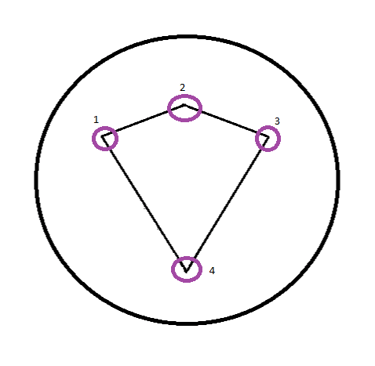

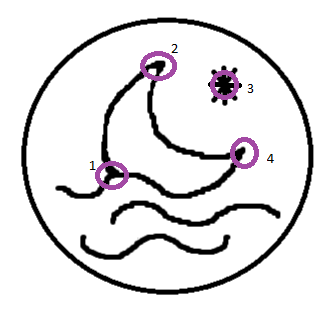
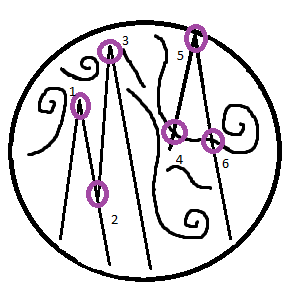



Bonded Benefit
Like Wizards, Scribes have learned how to guide Essence into defined, predictable structures, but Sigils are more dynamic. They cannot be stored in a focus for later use. Once the power is infused into the Sigil, it must immediately be expended or the Essence is lost. Because of this, Scribes have a great understanding of how Essence flows. They use their own Bonds to Essence to direct the magic into the Sigils and the Bonds of the spell’s target to focus it.
Sometimes a Sigil provides the Scribe an opportunity to draw upon more power than usual due to the harmony between the Sigil and their Soul Bond, the Soul Bond of the target, or both. This Bonded Benefit is listed on the Sigil Patten. Activating the Bonded Benefit is not required when you activate a Sigil, and often costs additional Intent.
Some examples of Sigils with Bonded Benefits:
Sigil of Life's Breath
Type: Battle
Tier: 1
Cost: 1
Tagline on Activation: Activate Air Stabilize
Description: One creature you touch becomes Stabilized from their Wounds. Undead and constructs can't be healed by this spell.
Bonded Benefit: If the caster has a Soul Bond to Air and the target has a Soul Bond to either Fire or Water, the Scribe may expend 1 additional Intent to immediately cast Air Accelerate Healing upon the same target.
Sigil of Thani's Endurance
Type: Enchantment
Tier: 1
Cost: 1
Tagline on Activation: Activate Air Refresh 1 Tolerance
Description: The target of the spell refreshes one point of Tolerance.
Bonded Benefit: If the caster has a Soul Bond to Air, and the target also has a Soul Bond to Air, the target of the spell may instead refresh two (2) points of Tolerance.


Glyphcraft
Glyphcraft is the oldest form of Inscription still remembered today. It uses Seraphic, the language of magic, to empower and stabilize inscribed Glyphs. It is possible, and sometimes necessary, to translate Poetic Speech words into Seraphic text, but using true Seraphic is preferred. In cases where the Scribe is using a direct phonetic translation of Poetic Script into Seraphic, the more Poetic Script words incorporated into a Glyph, the more likely it is to be unstable, have a shorter duration, or not work as intended.
For additional information about the commonly known Seraphic words important to basic Glyphcraft visit this document: Glyphcraft - Common Seraphic Words.
There are three categories of Glyphs: Blessing, Defense, and Barrier. Additionally, certain Defense and Barrier Glyphs may also incorporate a Sealing Glyph.
A Blessing Glyph is placed upon a threshold and grants a blessing to all who sleep in the room beyond that threshold. Defense Glyphs are designed to guard against specific creatures, unleashing magic on the specified creatures should they interact with it or pass by it. Barrier Glyphs are used by Scribes to create magical Walls and Circles.
You must have Glyphcraft in order to create and activate Glyphs, and a Scribe must possess the Pattern for the specific Glyph they wish to make. When a Scribe gains Glyphcraft, they will receive the following three Glyphs for their Pattern Book: Threefold Blessing, Setovru of Name, and Razor Quill.
The phys-rep for a Glyph is half a standard sized piece of paper (8.5x5.5 inches) turned sideways. The phys-rep should include the specific Glyph (as shown in its Pattern) and have the Out-of-Play tag attached.
A glyph that has been activated cannot be used again. However, you are welcome to reuse whatever prop you have for the glyph as long as you obtain a new Production tag.

Glyph Appearance
A standard glyph is represented by two overlapping pentagons (one pointed up and one pointed down), enclosed in a circle. Within the pentagons, Inscribed Seraphic text details the Source, the triggering effect, and the targeted creature(s). The Seraphic must be carefully written so as to join with the correct intersection points. There are three such joinings in each Glyph. The first joining has the Source; the second joining has the Triggering Effect, and the third joining specifies the targeted creature(s). Because it is one interconnected phrase, there is a start bracket at the first joining and an end bracket at the third joining.

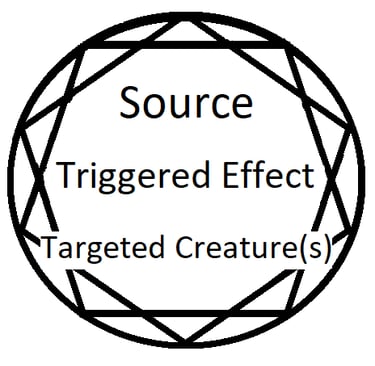

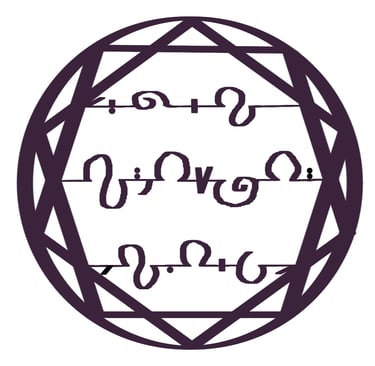
The one on the right is a Defense Glyph with a Triggered Light Lance against Gograzhi.
A discerning Scribe would notice that the Seraphic letters within the Glyph do not spell out “Triggered Light Lance against Gograzhi” in Poetic Script. They instead spell “Auran nuikael’ku inokh’at” which translates directly as “Light Lance’Triggered Gograzhi’target”.
It is possible, and sometimes necessary, to translate Poetic Speech words into Seraphic text, but using true Seraphic is preferred. In cases where the Scribe is using a direct phonetic translation of Poetic Script into Seraphic, the more Poetic Script words incorporated into a Glyph, the more likely it is to be unstable, have a shorter duration, or not work as intended.

Sealing Glyphs
Sealing Glyphs must always be combined with a Defense or Barrier Glyph as the primary Glyph provides the power necessary for the Seal to function.
They can be added to most Defense Glyphs as well as Glyphs that create magic Circles.


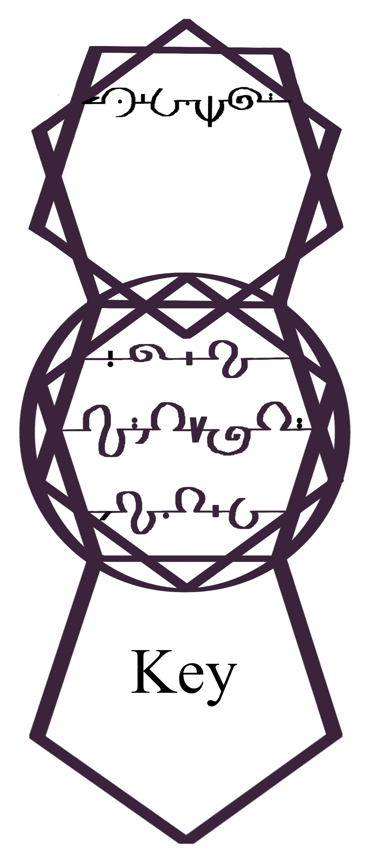

This uses the Defense Glyph with a Triggered Light Lance against Gograzhi as the primary Glyph.
Above the primary Glyph is the Seal Glyph. It is similar to a primary Glyph - two pentagons (one pointed up and one pointed down), but it is not enclosed in a circle. The base of the Seal Glyph’s upright pentagon overlaps the base of the primary Glyph’s upside down pentagon.
At the first joining, the Seraphic word for “active seal”(setovru) is written. Most often, the second and third joining are left empty. Leaving them blank Seals out all creatures, except those specified by the Key. However, especially in the case of Sealing Circles, the third joining may include a creature type or a name. The strongest Sealing Circles utilize a True Name within the Seal. Since the Seal, Glyph, and Key are one magical effect, the Seraphic opening bracket begins with “setovru” in the Seal and ends with the last Seraphic word in the Key.

Seal Key
Below the primary Glyph is the Key. The Key is a pentagon that is pointed down; its base overlaps with the base of the primary glyph’s upright pentagon. When the entity (or entities) signified on the Key touch the Key, it deactivates the entire Glyph. A second touch will reactivate it.
There are three types of Keys: Name, Password, and Soul Mark

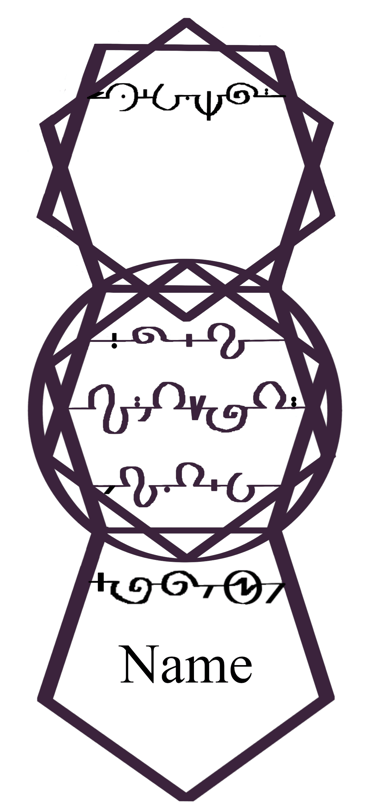
Name Key
Name Keys are the most common. The simplest Keys allow one named person, and the most advanced Keys allow up to five names. The names do not have to be written in Seraphic, and True Names are rarely used (as that would reveal a True Name to anyone who saw the Key). The Seraphic text indicates if it is a one, two, three, four, or five name Key. The beginning and end of the Seraphic must intersect with the outside edges of the Key, but, as there are no joinings, it doesn’t matter where it is written. However, it is usually written near the top. As mentioned above, the Seraphic closing bracket is on the last Seraphic word in the Key. The example to the left shows a one name Key.
Password Key
A Password Key allows the Scribe who created it to utter a password as the Glyph is activated. Touching the Key and speaking the password will deactivate the Glyph. Another touch while speaking the password reactivates it. Obviously, the password is not written on the Key. Instead, the Seraphic word “ayetlanaku” (literally “open only when word” in Poetic Speech) is Inscribed, as can be seen in the example.
(Out-of-Play: The Glyph should have the password written on the other side of the page, hidden from sight, but available if needed for a Marshal).

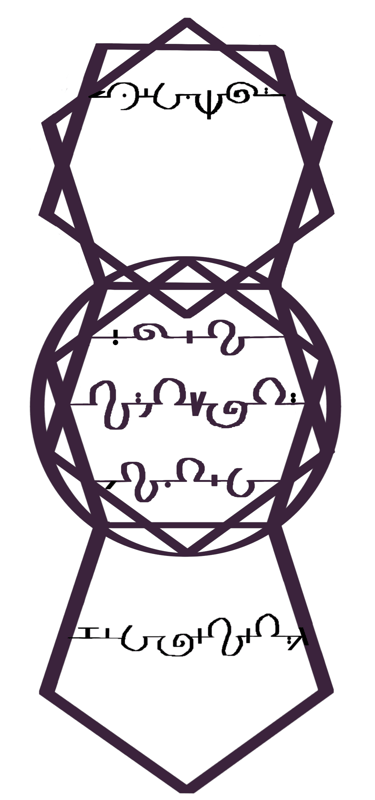
Soul Mark Key
Soul Mark Keys are difficult to create, and aren’t commonly used by humans. However, Gograzhi leaders often Mark their subordinates, which makes this a popular choice for them as a defensive measure. A creature with the specified Soul Mark will be wholly unaffected by the Glyph. The Key has the Seraphic word “rikalchi” Inscribed, usually at the top, and then the rest of the Key is the symbol of the Soul Mark. Here is an example, using a fabricated Soul Mark.
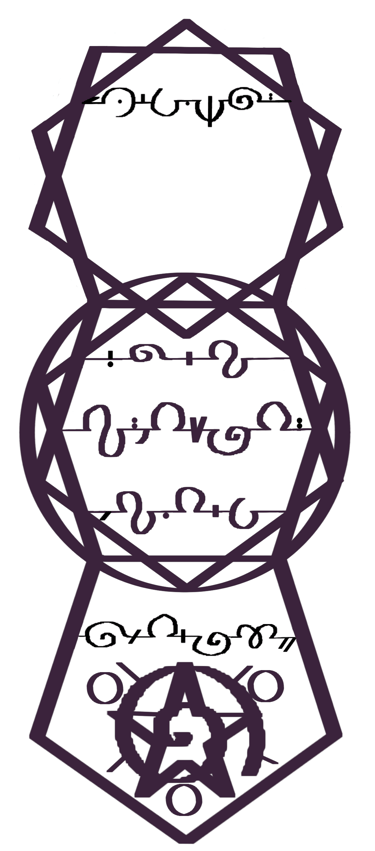


Types of Glyphs
There are three categories of Glyphs: Blessing, Defense, and Barrier.
Blessing Glyph
A Blessing Glyph is placed upon a threshold and grants a blessing to all who sleep in the room beyond that threshold. The Glyph is placed on the interior of the threshold or upon the inside of the door. It must be clearly visible, and anyone looking at an activated Glyph can sense that it is magical. Once activated, it lasts for three (3) days. It is then considered consumed and cannot be re-activated.
A creature who sleeps for more than three (3) hours in the room beyond the Glyph, is granted the Blessing when they step through the threshold.
The basic level Blessing Glyph grants the “Threefold Blessing”, which is three (3) Wards. The creating Scribe chooses the Wards from a short list of options.
The advanced Blessing Glyph grants the “Aegis of the Goddess”. This Blessing grants one (1) Resist in addition to three (3) Wards.
Only one Blessing Glyph may be placed on a threshold. The appearance of a Blessing Glyph is slightly different from a Defense or Barrier Glyph.
Defense Glyph
Defense Glyphs are designed to guard against specific creatures, unleashing magic on the specified creatures should they interact with it or pass by it. The Glyph is placed on the exterior of a threshold or door, upon the lid of a container, or upon the cover of a book. It must be clearly visible, and anyone looking at an activated Glyph can sense that it is magical. Once activated, it lasts for three (3) days. It is then considered consumed and cannot be re-activated.
When any part of a creature passes through the threshold or attempts to open the container, the effect on the Glyph triggers. The effect does not trigger if the creature enters the building in a different way, such as through the wall. In the case of a container, the effect does not trigger if the container suffers a Break or Shatter effect. However, that would also Break or Shatter everything within the container.
The effect of a Defense Glyph may be Warded or Resisted, but you cannot use any Defensive Maneuvers (Parry, Sidestep, Dodge, Countermagic). You may mitigate the effect with Armor or Toughness, if applicable.
Only one Defense Glyph may be placed on a threshold, container, or book. You may have a Blessing and a Defense Glyph on the same Threshold (one on the inside and one on the outside).
Barrier Glyph
Barrier Glyphs are used by Scribes to create magical Walls and Circles. The Glyph is attached to a rope of the appropriate length. The rope is considered In-Play, but a Scribe is not required to purchase a tag for it as its cost is included in the production cost of the Barrier Glyph. When the Glyph is activated, the rope is consumed as it channels the magic. It is encouraged (although not required) for the rope to incorporate battery operated lights or for the player to place down glow sticks when the Barrier Glyph is active to help distinguish it from a non-active Barrier.
A Wall Glyph should be attached to the center point of the ten (10) foot length of rope. The Scribe must lay out the rope in a straight line, and must be able to touch the Glyph as they activate it. Once activated, it lasts as long as the Scribe maintains Concentration or until the wall is Dispelled or Broken. Once it expires, it is considered consumed and cannot be re-activated.
A Circle Glyph may have the Glyph attached at any point of the circle, although it should be facing up once the rope is laid out into a circle. Once activated, it lasts as long as the caster remains Conscious within the Circle or until the Circle is Dispelled. Unlike with a Wall, the caster may grant others permission to cross the barrier and enter the Circle. Circles also empower the caster to cast spells upon individuals within the Circle.
Sealing Circle
When a Seal is added to a Glyph Circle, it reverses the magic of the Circle. Rather than just barring entry, it also prevents entities and magic from exiting. It can be used to temporarily cage a creature or magical phenomenon (such as a cursed object). Because of this, the caster must position themselves just outside the circle when they activate it. Once activated, the Sealing Circle lasts as long as the caster remains within five (5) feet (or “fist bump distance”) from the activated Glyph and maintains Concentration, or until the Circle is Dispelled.
If a specific target or name has been added to the Seal, and creatures of a different type or name are inside the Sealing Circle when it activates, they are able to exit. However, once activated, nothing can enter the Circle.
When a magical phenomenon or entity is trapped within a Sealing Circle it usually forces the magic or entity to manifest in a physical form. This allows for communication or confrontation with it. Sometimes when the physical form is destroyed, it destroys the magical phenomenon or entity, but that method is not guaranteed.

Destroying Glyphs
With enough magical force, it is possible to destroy a Blessing or Defense Glyph. This must be done with caution, however, because attacking a Glyph will result in a magical backlash that affects not just the attacker but every creature nearby.
Glyphs are immune to physical attacks and non-damaging magic (except Dispel effects that can target a Glyph). You cannot successfully attack a Glyph using the same Source as the Source that powers it. Doing so would either have no effect or could even strengthen the Glyph. Extremely powerful Glyphs Sourced with Kal’tov or Kal’inokh would require an equally powerful Sourced attack, or may be immune to destruction.
A standard Glyph requires three (3) Arrow effects or one (1) Lance effect to destroy it. Each hit reflects the damage back on the caster using the Source of the Glyph. For example, a Water Arrow against it would immediately be reflected back as a Triggered Magic [Source] Arrow.
A Blast effect Destroys the Glyph without causing a backlash.
Due to their nature, Barrier Glyphs cannot be destroyed. They can be Dispelled with a Dispel Wall or Dispel Circle effect. A Wall can be targeted by a Break Wall effect, which causes the caster to take a Dart to a Limb (same Source as the Wall). If this causes the caster to break their Concentration, then the Wall drops.


Sigilcraft Tattoos
Master Sigilcrafters learn how to Inscribe not just upon paper or even skin, but upon the very Soul. They draw forth the Soul’s Essence to create a permanent tie with the Soul - just as the ink of the visible tattoo permanently marks the skin.
Although similar in how it is described, a Sigilcraft Tattoo does not create a Soul Bond. A Soul Bond is the Soul’s natural flow of Essence towards a particular Aspect. A Sigilcraft Tattoo functions more like an Arcanatech enchantment that uses the Soul as a power source. It does not require the target to have a Soul Bond to a particular Aspect as every Soul contains all Aspects of Essence.
The process can be very taxing on the Soul. Therefore, you cannot have more than five (5) tattoos and it is impossible to have duplicates of the same tattoo. The tattoos must be physically spaced far enough apart that the Soul ties do not intersect. This means that the five (5) locations for a tattoo are the same as the five (5) possible Wound locations: torso, left and right arm, and left and right leg. This toll this takes on the target’s Soul also means that Sigilcraft requires not just components and a Scribe’s time, but a piece of the target’s Soul (i.e - it requires the target to spend Experience Points).
A Scribe must have the Pattern for the tattoo they wish to create within their Book of Patterns. Sigilcraft Tattoos require unique and rare components, which will be listed on their Pattern.
Because the connection with the Soul is more important than the physical ink of the tattoo, there is a great deal of flexibility in how a tattoo may look, although every tattoo does have specific design specifications that must be followed. All tattoos have a minimum size requirement of two (2) inches by two (2) inches or four (4) square inches. Tattoos are not required to be visible at all times, but must be in a location that could be visible to others (without requiring an R rating).
There are five (5) tattoos - one (1) for each Aspect - that have been studied and perfected in current age. Each provides a passive, innate defense and a magical Form based on the Aspect Source of the tattoo. The magical Form grants the individual additional abilities, but it requires a great deal of Soul energy. The Form only stays active for ten (10) minutes and an individual must complete a Short Rest before activating that tattoo’s Form again. If an individual has more than one (1) tattoo, they can only activate one Form at a time. Once a Form ends, they may activate a different tattoo’s Form.
